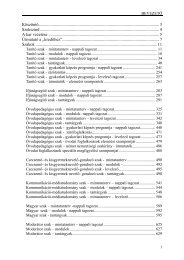ACTA SZEKSZARDIENSIUM - Pécsi Tudományegyetem Illyés Gyula ...
ACTA SZEKSZARDIENSIUM - Pécsi Tudományegyetem Illyés Gyula ...
ACTA SZEKSZARDIENSIUM - Pécsi Tudományegyetem Illyés Gyula ...
Create successful ePaper yourself
Turn your PDF publications into a flip-book with our unique Google optimized e-Paper software.
Zoltán Raffay<br />
deficits, maritime safety and pollution, growing gap between rich and poor nations,<br />
terrorism etc.), the necessity to develop the tourism sector in a direction that does not<br />
prevent the future generations from enjoying the tourism attraction that we can enjoy<br />
today became a more and more often raised issue. The World Tourism Organization and<br />
other organisations interested in tourism development first defined sustainable tourism<br />
and ecotourism and then started to pay more attention to this tourism activity, besides<br />
other tourism branches, of course. Sustainable tourism in the WTO’s definition is seen as<br />
management of all resources in such a way that economic, social and aesthetic needs can<br />
be fulfilled while maintaining cultural integrity, essential ecological processes, biological<br />
diversity and life support systems- integrating the idea of sustainable development and<br />
tourism, actually, where sustainable development is seen as “meeting the needs of the<br />
present without compromising the ability of future generations to meet their own needs”<br />
(World Commission on Environment and Development, 1987). Ecotourism, also known<br />
as ecological tourism, is “responsible travel to fragile, pristine, and usually protected<br />
areas that strives to be low impact and (often) small scale. It helps educate the traveller;<br />
provides funds for conservation; directly benefits the economic development and<br />
political empowerment of local communities; and fosters respect for different cultures<br />
and for human rights” (wikipedia.org).<br />
“In late 1970s and early 1980s the world organisations of nature and environment<br />
protection were created and they drew attention to the problematic impacts on the natural<br />
and social environment induced by the travels. Their campaigns resulted in the organisation<br />
of the first eco-minded tours and to the birth of ecotourism per se as a form of travel. The first<br />
definition of ecotourism was made by Hector Ceballos Lascuráin, and this way ecotourism<br />
was raised to the level of the other tourism sectors and was given more and more attention, due<br />
to the ever strengthening global and local movements of environment and nature protection.<br />
The appearance and development of ecotourism thus perfectly fits into the worldwide trends:<br />
the appreciation of nature, increased environmental consciousness, evaluation of health and<br />
healthy environment, self-expression, the strengthening of individualisation, the search for<br />
authentic values (or values looking) authentic, globalisation and the access to information.”<br />
(TÁMOP.-4.1.2-08/1/A project)<br />
2. Ecotourism in Hungary<br />
2.1. The ecotourism potential of Hungary<br />
Hungary is extremely rich in natural values, not lat partly due to the belated economic<br />
development of the country that allowed the survival of many natural or quasi natural<br />
areas, plain lands, marshes, flood plains, pastures, grasslands and forests. These areas<br />
are home to a spectacular fauna and flora, including many indigenous and rare species.<br />
Hungary now has no less than 10 national parks, 36 areas of landscape protection and<br />
152 nature protection areas of national importance (Figure 2).<br />
100




